New figures published by the Clean Energy Regulator (CER) show Australia’s renewable energy market continued to set new records in 2021 but Bloomberg New Energy Finance (BloombergNEF) analyst Leonard Quong says the nation’s embrace of rooftop solar PV may be on the slide.
“Australia’s residential solar market will pass its 2021 peak and deteriorating economics will see annual capacity additions slide to 2.5GW in 2022,” Quong said.
“The fall in installations have less to do with physical saturation of rooftops, although that is a factor, and more to do with the impact a tidal wave of solar is having on the market.”
The CER’s December 2021 Quarterly Carbon Market Report shows Australia set renewable energy records for the fifth consecutive year in 2021 with approximately 380,000 rooftop solar PV systems installed across the nation. The record number of installs delivered a combined total of 3.2GW of rooftop solar PV capacity, 7% more than the 3GW installed in 2020.
That surge led Australia’s clean energy generation to a record 31.4% of all electricity produced in the National Electricity Market (NEM), more than double the 15% renewable energy delivered to the market in 2017.
CER chair David Parker said rooftop solar had been a key contributor as renewable energy had continued to shine in 2021, with almost one third of the nation’s households now generating solar power on their roofs.
“Rooftop solar PV led the way for renewable energy with a record 3.2GW installed in 2021, despite extensive lockdowns and reduced installations in two of Australia’s biggest markets – New South Wales and Victoria,” he said.
“Australia’s uptake of rooftop solar PV at over 3 million systems and over 16GW of capacity is world leading, with one in three suitable homes now having rooftop solar.”

Image: ARENA
Despite rooftop solar’s impressive performance in 2021, Sydney-based Quong said market influences, including network curtailment of excess renewable energy have emerged as legitimate deterrents for those looking to make the switch to solar.
“The economic appeal of solar is declining as federal government rebates wind down and network operators put in place new rules to limit and control rooftop solar exports,” he said.
Quong said the curtailment regulations and winding back of rebates, combined with lower retail rates, have increased the time it takes for homeowners to see a return on their investment.
Meanwhile, Quong said decades of policy uncertainty and the challenges of integrating renewable energy into grids are starting to take a toll on solar.
BloombergNEF said investment in large-scale renewable energy capacity was just $2.2 billion in 2021, down 67% from its record high in 2018.
Despite forecasting a decline in rooftop solar installs for 2022, Quong said there is cause for optimism.
“There are bright spots on the horizon, corporate power purchase agreements (PPAs) and state policies continue to drive demand for new capacity,” he said.
“States ambitions alone could see Australia exceed 60% renewable energy supply by 2035.”
This content is protected by copyright and may not be reused. If you want to cooperate with us and would like to reuse some of our content, please contact: editors@pv-magazine.com.









By submitting this form you agree to pv magazine using your data for the purposes of publishing your comment.
Your personal data will only be disclosed or otherwise transmitted to third parties for the purposes of spam filtering or if this is necessary for technical maintenance of the website. Any other transfer to third parties will not take place unless this is justified on the basis of applicable data protection regulations or if pv magazine is legally obliged to do so.
You may revoke this consent at any time with effect for the future, in which case your personal data will be deleted immediately. Otherwise, your data will be deleted if pv magazine has processed your request or the purpose of data storage is fulfilled.
Further information on data privacy can be found in our Data Protection Policy.